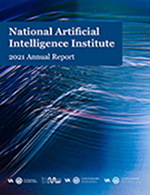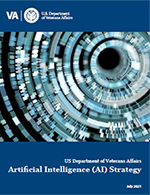Office of Research & Development |
 |

© iStock/INDU BACHKHETI
|
|
Events & Announcements |
|
|
Resources & Publications |
|
|
Newsroom |
| |
For Media |
The White House released the AI Bill of Rights in October 2022 to “help guide the design, development, and deployment of artificial intelligence and other automated systems so that they protect the rights of the American public.” To protect Veterans and support their health care, the Department of Veterans Affairs (VA) has instituted a Principle-Based Ethics Framework for Access to and Use of Veteran Data and launched the AI@VA Community and Network to pilot programs that will provide Veterans with information about any AI system used in their health care and ensure AI risks are managed during human subjects research. Read the White House Bill of Rights Fact Sheet .
NAII Annual Report 2021In 2021, NAII expanded its capacity by launching initiatives that will shape the future of VA's work on AI-powered technologies, services, and research. NAII introduced research projects and collaborative initiatives in addition to placing staff across a growing AI network of medical centers and offices across VA. Download report |
 |
VA Artificial Intelligence StrategyIn 2021, VA was one of the first federal agencies to release an AI strategy. The NAII pulled together input from offices across VA to help develop VA's strategy for advancing AI to improve Veterans' care. Read the VA AI Strategy. |
 |
This paper analyzes departmental strategies and provides a purview of themes that invite and ease cross-agency collaboration, particularly common themes discovered in this analysis such as: developing standards and workforce, potential opportunities for innovation and investment, creating AI infrastructure, and establishing governance systems.
Leveraging Machine Learning to Characterize the Role of Socio-economic Determinants on Physical Health and Well-being Among Veterans
Computers in Biology and Medicine
Makridis, Christos A., David Zhao, Adi Bejan, and Gil Alterovitz. (2021)
Understanding the contributions of demographic, socio-economic, and geographic characteristics as determinants of physical health and well-being is essential for guiding public health policies and preventative behavior interventions, particularly with the spread of coronavirus. We leverage several machine learning methods to build predictive models of overall well-being and physical health among Veterans as a function of these three sets of characteristics. We link Gallup's US Daily Poll between 2014 and 2017 over a range of demographic and socio-economic characteristics with zip code characteristics from the Census Bureau to build predictive models of overall and physical well-being. Although the predictive models of overall well-being have weak performance, our classification of low levels of physical well-being performed better. Gradient boosting delivered the best results (80.2% precision, 82.4% recall, and 80.4% AUROC) with perceptions of purpose in the workplace and financial anxiety as the most predictive features. Our results suggest that additional measures of socio-economic characteristics are required to better predict physical well-being, particularly among vulnerable groups, like Veterans. Reliable and effective predictive models will provide opportunities to create real-time and personalized feedback to help individuals improve their quality of life.
Designing Covid-19 Mortality Predictions to Advance Clinical Outcomes: Evidence from the Department of Veterans Affairs.
Accepted, BMJ Health & Care Informatics
Makridis, Christos A., Tim Strebel, Vince Marconi, and Gil Alterovitz. (2021)
Using administrative data on all Veterans who enter the Department of Veterans Affairs (VA) medical centers throughout the United States, this paper uses machine learning methods to predict mortality rates for COVID-19 patients between March and August 2020. First, using comprehensive data on over 10,000 Veterans' medical history, demographics, and lab results, we estimate five AI models. Our XGBoost model performs the best, producing an AUROC and AUPRC of 0.87 and 0.41, respectively. Second, through a unique collaboration with the Washington DC VA medical center, we develop a dashboard that incorporates these risk factors and the contributing sources of risk, which we deploy across local VA medical centers.
How Much Does the (Social) Environment Matter? Using Artificial Intelligence to Predict COVID-19 Outcomes with Socio-demographic Data
Pacific Symposium on Biocomputing
Makridis, Christos A., Anish Mudibe and Gil Alterovitz. (2020)
While the coronavirus pandemic has affected all demographic brackets and geographies, certain areas have been more adversely affected than others. This paper focuses on Veterans as a potentially vulnerable group that might be systematically more exposed to infection than others because of their co-morbidities, i.e., greater incidence of physical and mental health challenges. Using data on 122 Veteran Healthcare Systems (HCS), this paper tests three machine learning models for predictive analysis. The combined LASSO and ridge regression with five-fold cross-validation performs the best. We find that socio-demographic features are highly predictive of both cases and deaths–even more critical than any hospital-specific characteristics. These results suggest that socio-demographic and social capital characteristics are important determinants of public health outcomes, especially for vulnerable groups, like Veterans, and should be investigated further.
(Why) Is There a Public/Private Pay Gap?
Accepted, Journal of Government and Economics.
Makridis, Christos A. (2021).
The government is facing a severe shortage of skilled workers. The conventional wisdom in branches of policy and public administration is that this worker deficit is driven by uncompetitive salaries that are not attracting top talent. Using longitudinal data on high skilled workers between 1993 and 2013, this paper shows that, if anything, government employees earn more than their private-sector counterparts. Although government workers tend to earn less in the raw data, these differences are driven by the correlation between unobserved productivity and selection into private-sector jobs. Instead, this paper provides empirical evidence that low non-pecuniary amenities, such as development opportunities and management, can explain earnings differences between the public and private sectors.
(How) Does Artificial Intelligence Raise Well-being? The Service Revolution and Economic Growth
Invited for special issue, Journal of Services Research
Makridis, Christos A., and Saurabh Mishra. (2021)
The share of artificial intelligence (AI) jobs in total job postings have increased from 0.2% to nearly 1% between 2010 to 2019, but there is significant heterogeneity across cities in the United States (US). Using new data on the AI job postings across 343 US cities, combined with data on subjective well-being and economic activity, we uncover the central role that service-based cities play to translate the benefits of AI job growth to subjective well-being. We find that cities with higher growth in AI job postings witnessed higher economic growth. The relationship between AI job growth and economic growth is driven by cities with higher concentrations of modern (or professional) services. AI job growth also leads to an increase in the state of well-being. The transmission channel of AI job growth to increased subjective well-being is explained by the positive relationship between AI jobs and economic development. These results are consistent with structural transformation models where technological change leads to improvements in well-being through improvements in economic activity. By empowering the modern service economy across cities, our results suggest that AI-driven economic growth could also raise overall well-being and social welfare.
VA adopts new artificial intelligence strategy to ensure trustworthy use of technology for Veteran care
VA Office of Public and Intergovernmental Affairs, October 14, 2021
2023
Listen: VA’s ASPIRE Program is Improving Data Literacy
GovCIO, April 4, 2023
Data Literacy Programs Are Taking Shape Across Government
GovCIO, March 29, 2023
Listen: Continuing VA's Journey For AI in Health Care
GovCIO, March 21, 2023
Ethical AI Miniseries: VA Developing Strategies for AI Governance
Gov CIO, January 24, 2023
2022
Listen: An Inside Look at VA’s National AI Network, Gov CIO
December 27, 2022
White House’s ‘AI Bill of Rights’ Codifies Ethical Use, Privacy
Gov CIO, October 31, 2022
White House releases Blueprint for an AI Bill of Rights
VA Research Currents, October 6, 2022
Listen: VA Kicks Off Summit of AI, ML Impacts on Brain Health
Gov CIO, September 6, 2022
BRAIN Summit: Leveraging AI to explore new frontiers in brain health for our nation’s Veterans
VA News, August 26, 2022
How Emerging Tech is Improving Veteran Health Care Access
Gov CIO August 25, 2022
VA piloting trustworthy AI checklists for new and existing projects
FedScoop, July 13, 2022
A look at VA Machine Learning & Artificial Intelligence progress - FedHealthIT
Fed Health IT, April 14, 2022
How an AI-powered tool could help diagnose skin cancer in veterans | Healthcare IT News
Healthcare IT News, April 1, 2022
GovCIO Newscast: Live from HIMSS: AI Sprints are Helping VA Create Health Care Tools - FedHealthIT
Gov CIO, March 16, 2022
Key Efforts for Building the Federal AI Talent Pipeline
Gov CIO, February 14, 2022
2021
AI is Driving Accessibility, Equity in VA Health Care
GovCIO, December 22, 2021
Data Partnerships Essential for AI Development
GovCIO, December 10, 2021
VA’s New AI Strategy Targets Ethics, Trust
GovCIO, October 25, 2021
VA’s Road to Trustworthy AI with Transparency, Standards
Gov CIO, August 23, 2021
VA piloting system to find and manage AI talent (fedscoop.com)
FedScoop, August 23, 2021
Listen: Breaking Down AI Tech Sprints at Veterans Affairs
GovCIO, July 23, 2021
New VA tool uses artificial intelligence to predict COVID-19 patient mortality
VA Research Communications, June 28, 2021
Workforce 4.0: Americans Tackle Artificial Intelligence
Forbes, May 3, 2021
VA National Artificial Intelligence Institute (NAII) to award Curapatient hosted, cloud-based, COVID-19 Care Plan Management solution contract
FedHealthIT, January 27, 2021
2020
Gil Alterovitz: VA Tests Artificial Intelligence ‘To-Go’ Delivery Model (executivegov.com)
ExecutiveGov, July 15, 2020
A Look at the new National Artificial Intelligence Institute (NAII) at the Department of Veterans Affairs
FedHealthIT, March 10, 2020
Advancing AI Through Collaborative Sprints at VA
GovCIO, January 29, 2020
2019
VA aims to expand artificial-intelligence research, appoints inaugural AI director
VA Research Communications, July 10, 2019
If you have questions please email NAII@va.gov
Thank you for your interest in the NAII.
Please fill out all required segments and optional portions to the best of your knowledge, so we can properly answer your questions.
*Due to time constraints, we cannot guarantee every request will be accommodated.